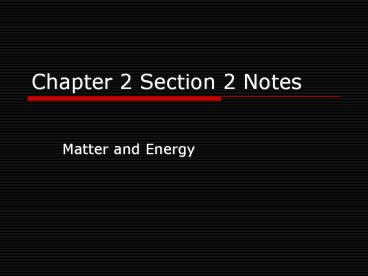Chapter 2 Section 2 Notes - PowerPoint PPT Presentation
1 / 23
Title:
Chapter 2 Section 2 Notes
Description:
Chapter 2 Section 2 Notes Matter and Energy Kinetic Theory of Matter: Useful for seeing differences in the 3 common states of matter on earth: solid, liquid, and gas. – PowerPoint PPT presentation
Number of Views:138
Avg rating:3.0/5.0
Title: Chapter 2 Section 2 Notes
1
Chapter 2 Section 2 Notes
- Matter and Energy
2
Kinetic Theory of Matter
- Useful for seeing differences in the 3 common
states of matter on earth solid, liquid, and
gas.
3
Kinetic Theory of Matter3 Main Points
- All matter is made of atoms and molecules which
act like tiny particles that are always in
motion. - The higher the temperature, the faster the
particles move. - At the same temperature, heavier particles move
slower than lighter particles.
4
States of Matter
- Solid particles are in a fixed position
- rigid structure no freedom to change positions
- Particles are held closely together by strong
attractions - Diagram
5
Liquid
- Liquid particles are closely packed, but can
still slide past each other - Take the shape of their container
- Particles are close but not as close as a solid
- Particles can move randomly and spread on their
own - Diagram
6
Viscosity
- Viscosity resistance of a fluid to flow
- syrup is more viscous than water
- Determined by the attraction of particles the
stronger the attraction, the more viscous (thick)
the liquid is.
7
Gas
- Gas particles are in a constant state of motion
and rarely stick together - expand to fill available spaces
- Example scents of food or perfume
- Diagram
8
(No Transcript)
9
Gas
- A balloon filled with helium is under pressure
Pressure force exerted per unit area of a
substance - If there is too much pressure (too many helium
particles) in a balloon, what happens? - A gas under pressure will escape the container if
possible. Think about an air filled balloon that
you let go.
10
Kinetic Theory
- Using the Kinetic Theory of matter, explain why a
balloon filled with helium goes flat faster than
one filled with regular air.
11
Fluids
- Fluids substances that can spread
- Both liquids and gases can spread, so they are
considered fluids.
12
Plasma
- Plasma most common state of matter in universe
NOT on Earth - Makes up 99.9 of the universe
- Plasma is superheated gas and is a collection of
free moving electrons and ions the term came
about in 1920s to represent electrically charged
particles at high energy
13
Plasma
- Examples of plasma on earth
- lightning
- fire
14
Energy
- Energy the ability to change or move matter
- Examples of energy or sources of energy
- heat, light, spring coiling, batteries
- Energy must be ADDED to melt or evaporate
substances - Aluminum must be melted before it can be recycled
- As aluminum particles gain heat, particles move
faster and break away from fixed positions and
become liquids called melting
15
Energy
- Energy must be RELEASED to make a gas become a
liquid or solid again. - When H2O is a gas and molecules slow down the
water vapor returns to a liquid (called
condensation). When molecules slow down even
more, the water goes to a solid (ice).
16
Energy
- Energy relationship between solid, liquid, and
gas diagram
liquid
gas
solid
Energy ABSORBED
Energy RELEASED
17
(No Transcript)
18
Important Note
- Changing the state of matter does NOT change the
substance or mass. - Water, steam, and ice are all H2O the only
change is the nature of attraction between
molecules
19
Phase Change Diagram
Solid
Melting
Sublimation
Deposition
Freezing
Condensation
Liquid
Gas
Evaporation
20
Phase Changes
- Evaporation change of a substance from a liquid
to a gas. - Condensation change of a substance from a gas to
a liquid. - Sublimation change of a substance from a solid
to a gas. - Deposition change of a substance from a gas to a
solid - Example Water vapor without becoming liquid-
this is how snow forms in clouds.
21
Law of Conservation of Mass
- Law of Conservation of Mass Mass cannot be
created or destroyed - Example Burning a match consider what you
start and end with.
22
Trivia Question
- Trivia Question If mass cannot be created or
destroyed, then why do we have to replace our
tires when the rubber wears away?
23
Law of Conservation of Energy
- Law of Conservation of Energy Energy cannot be
created or destroyed - Energy can be converted from one form to
another. - Example A wristwatch from chemical energy to
mechanical energy.































